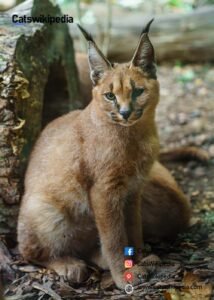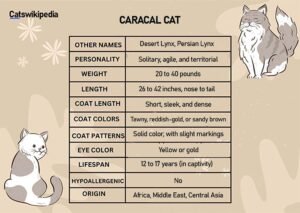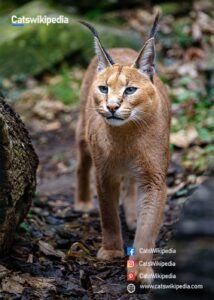Caracal Cat
History of the Caracal Cat
The name “Caracal” comes from the Turkish term “karakulak,” which, indeed means “black ear,” well-describing an unusually impressive-looking black-tufted ears. A native to parts of Asia, Middle East and Africa, the Caracal is as famous as she is in history as a huntress. All the above features bestowed with its sleek body, sharp eyesight, and phenomenal speed had set it among the precious hunting companions of the ancient. In fact, they found their bases for hunting birds and small game in Egypt and India. The title of the legendary creature for Caracal has survived for a long time because of its massive leap into the air reaching up to ten feet when catching prey.

Caracal Cat Physical Characteristics
The body of medium-sized wild cats and caracals is characterized by firm, muscular legs as well as sleek, slim bodies. They are, in fact the largest of Africa’s tiny cats with a short, dense, and smooth coat in shades of tawny-brown to reddish-tan. Underparts are normally paler almost white. The face of the Caracal forms one of its most remarkable features with black lines as well as white dots round its eyes, The look is solid and alluring.
They have long black tufts on their ears that can be up to 1.75 inches long. The tufts may help the waves of sound that reach to their ears to facilitate better communications so are not just appendages for cosmetic purposes. Ironically, every ear has around 20 muscles which allow incredible flexibility and precision in the ability to hear any sound. The Caracal is a pretty majestic and highly evolved creature when it comes to its feature for survival in the wild.
How heavy does the Caracal weigh?
The male caracal cat is typically more massive and heavier compared to the females. They have a mean weight ranging from 8 to 18 kilograms. These cats can be as long as one meter if their tails are excluded. Most wild cat species have gender size differences. Males are always primarily positioning themselves in the center of the attraction of their surroundings.
Is the Caracal Fast?
The speed of the Caracal cat is approximately 50 miles per hour, which translates to 80 kilometers per hour., That in turn makes it a fast and agile predator. Its strong legs, with a quick reflex, make it dangerous in the wild.

Can a Caracal Jump High?
Caracal is known for its great acrobatic prowess. One is able to jump up to 4 meters (about 13 feet) in the air to catch its prey. Due to their impressive jumping capability, they can snatch birds and other animals from midair, which exhibits their impressive hunting and adaptability skills when they operate on mixed terrains.
Where Does the Caracal Live?
Caracal cats come from the regions of Africa and parts of the Middle East, varying habitats – savannas and woodlands to deserts. It can be found from the Arabian Peninsula to Northwest India. With this adaptability, the Caracal could thrive in several types of terrain, even the lushest forests and arid deserts.

Habitat of Caracal Cat
The Caracal is an adaptable wild cat, and they thrive well in Caracal environments anywhere in Africa, the Middle East, and Central Asia. Caracals can be found in virtually all types of habitat across Africa, from the vast savannas to the arid desert regions of the Sahara and even more wooded areas. They are among Africa’s most versatile wild cats due to their ability to survive in areas that other predators would find difficult to thrive in.
The caracal cat mainly inhabits deserts and other arid regions of the Middle East, where they have developed remarkable survival techniques. They survive with very little water and food by hunting small mammals, birds, and reptiles. In this region, they are said to inhabit more forested regions where they take advantage of the extra foliage for hunting and concealment.
The range of Caracals stretches from Caracal’s islands, mountainous lands, and desert territories in Central Asia. Its extreme versatility is demonstrated by its ability to hunt as well as travel in such a wide range of surroundings. The Caracal is an absolute survivor of the wild; they can withstand the challenges of changing habitats. They can climb steep rock outcrops to chase prey or else melt into long grasses of vast plains.
Average lifespan of a caracal in the wild, facing predators and many natural challenges, is about 12 years. When fed and treated regularly, their lifespan becomes much higher, up to 16 years or more in captivity.
The Caracal Field Under Analysis
The Caracal cat is an elegantly beautiful cat, well recognized by its classy look, agility, and adaptation to living in multiple climates. This intermediate-sized indigenous cat from Africa, the Middle East, and Central Asia is quite capable of living in a wide range of habitats. Its tawny-brown color and tufted ears with black color and outstanding facial lines identify it easily. It is a dangerous hunter because of its robust bulk and swift speed that can reach up to 50 miles per hour.

A caracal cat can jump up to four meters in the air to catch some prey, giving them that super agility. They are great at survival in hostile environments. With about 20 muscles apiece, their ears are exquisitely calibrated instruments that improve their hearing, which will help them communicate and hunt. A caracal’s life span varies; wild cats can live up to 12 years, while captive ones can live up to 16 years or more due to the preservation and care provided by human habitats.
Conclusion
The Caracal which roams about such easy grace in expansive lands around its range is a testimony of adaptability and strength. It presents as one of the fascinating and most proficient predators on the wild scene because of the unique features that make it so well suited for survival.



